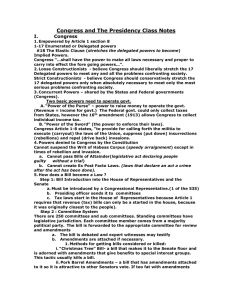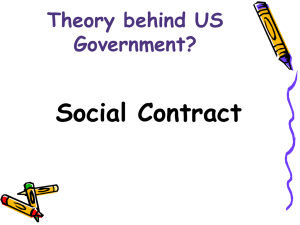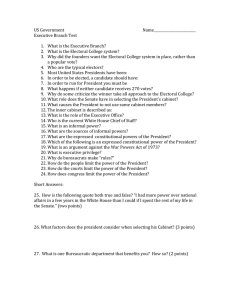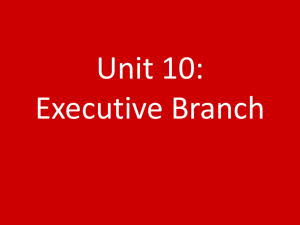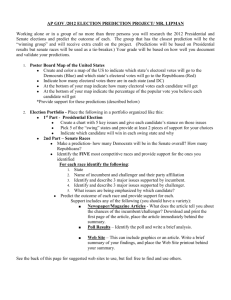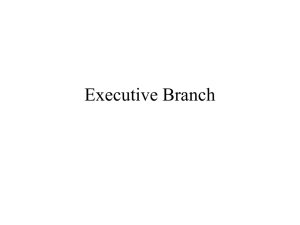Class Notes I Congress
advertisement
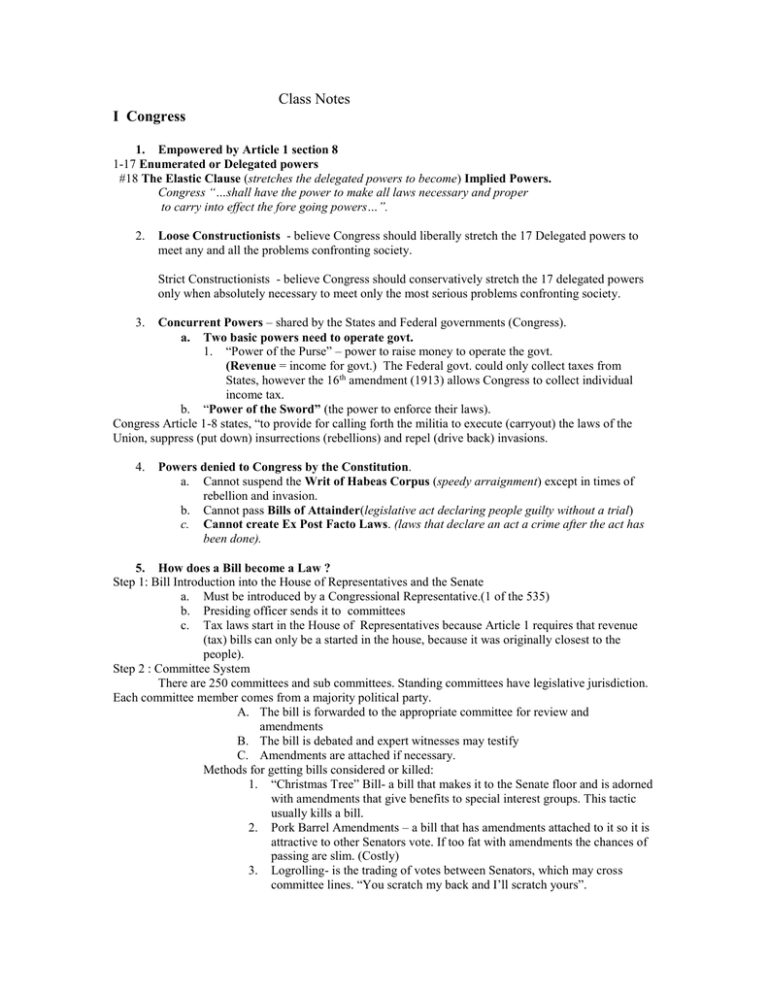
Class Notes I Congress 1. Empowered by Article 1 section 8 1-17 Enumerated or Delegated powers #18 The Elastic Clause (stretches the delegated powers to become) Implied Powers. Congress “…shall have the power to make all laws necessary and proper to carry into effect the fore going powers…”. 2. Loose Constructionists - believe Congress should liberally stretch the 17 Delegated powers to meet any and all the problems confronting society. Strict Constructionists - believe Congress should conservatively stretch the 17 delegated powers only when absolutely necessary to meet only the most serious problems confronting society. Concurrent Powers – shared by the States and Federal governments (Congress). a. Two basic powers need to operate govt. 1. “Power of the Purse” – power to raise money to operate the govt. (Revenue = income for govt.) The Federal govt. could only collect taxes from States, however the 16th amendment (1913) allows Congress to collect individual income tax. b. “Power of the Sword” (the power to enforce their laws). Congress Article 1-8 states, “to provide for calling forth the militia to execute (carryout) the laws of the Union, suppress (put down) insurrections (rebellions) and repel (drive back) invasions. 3. 4. Powers denied to Congress by the Constitution. a. Cannot suspend the Writ of Habeas Corpus (speedy arraignment) except in times of rebellion and invasion. b. Cannot pass Bills of Attainder(legislative act declaring people guilty without a trial) c. Cannot create Ex Post Facto Laws. (laws that declare an act a crime after the act has been done). 5. How does a Bill become a Law ? Step 1: Bill Introduction into the House of Representatives and the Senate a. Must be introduced by a Congressional Representative.(1 of the 535) b. Presiding officer sends it to committees c. Tax laws start in the House of Representatives because Article 1 requires that revenue (tax) bills can only be a started in the house, because it was originally closest to the people). Step 2 : Committee System There are 250 committees and sub committees. Standing committees have legislative jurisdiction. Each committee member comes from a majority political party. A. The bill is forwarded to the appropriate committee for review and amendments B. The bill is debated and expert witnesses may testify C. Amendments are attached if necessary. Methods for getting bills considered or killed: 1. “Christmas Tree” Bill- a bill that makes it to the Senate floor and is adorned with amendments that give benefits to special interest groups. This tactic usually kills a bill. 2. Pork Barrel Amendments – a bill that has amendments attached to it so it is attractive to other Senators vote. If too fat with amendments the chances of passing are slim. (Costly) 3. Logrolling- is the trading of votes between Senators, which may cross committee lines. “You scratch my back and I’ll scratch yours”. 4. Killing a Bill – most bills (98%) do not make it through their committees. Motivations for a Senator: 1. Re-election Motivation—the bill directly affects the State. 2. Motivation by Leadership—assisting in passing the bill with the promise of a committee chairmanship 3. Seeking Higher Office- active participation, taking a key position, and name recognition on important bills 4. Serving Constituents- having their voters best interest in mind. (Source: ICONS, Univ of MD Senate Simulation) Step 3: House Rules Committee a. The bill is discussed by the entire house Step 4: House and Senate Floor a. The Bill is debated and voted on by the entire House of Representatives and the Senate separately. The bill may be of the same language or similar. b. House time allotment is 30 mins per Rep. The Senate has no time limit and a technique called Filibustering is used to stop the momentum of a bill in order to prevent its passage. ***(The longest filibuster was by So.Carolina Sen. Strom Thurmond 24hrs and 18min during the Civil Rights Act of 1957 debate) One way to stop a filibuster is by Cloture- a vote by Senators. 60 votes are needed. Step 6B: Conference Committee a. The Bill is introduced a joint committee of House of Representatives and Senators to resolve their differences. b. Compromised bills is sent back to the House of Representative and the Senate Floor Step 7: President a. b. c. Bill is given to the President, who has 2 options. Sign it into law or if the President wish not to have his name attached to the passage of the bill, then he does nothing and the bill will automatically become law. Veto- is sensitive to the time left to the Congressional Session 1. less than 10 days left---Pres. Does not send the bills back. This is known as a Pocket Veto. 2. more than 10 days he must send it back to Congress. This veto can be overridden by 2/3rds vote in each house. II The Presidency A. Constitutional Roles 1. Leadership " Chief Executive" The Presidents chief responsibilities include giving leadership to the immense U.S. Government (3 million people/ 1 Trillion dollar budget) and recommending a workable budget to Congress. a. Directs the work of his cabinet heads. In George Washington's administration he had 4 cabinet heads. Today there are --soon to be cabinet positions. Secretary of: Agriculture Commerce health and human services Defense Education Housing and Urban development Energy Justice interior Treasury labor State Transportation veterans affairs **(Home land Security) b. Enforces al Federal Laws c. Supervises agencies that assist him in his duties as President ex’s. OMB (Office of Management and Budget)-prepares a spending plan for the year CIA (Central Intelligent Agency) gathers info on foreign matters for national security FBI (Fed Bur of Inv). Investigates Federal law violations NASA (Nat’l Aeronautic + Space Admin) directs space exploration 2. Military Leader “Commander in Chief” …of the armed forces. He out ranks every General and Admiral. a. highest military rank b. approves major military decisions 3. Legislative Leader a.Veto’s or signs Act of Congress into laws. 4. Diplomatic Leader a. Makes treaties (with 2/3rds congressional approval). b. Receives foreign ambassadors c. Nominates U.S. ambassadors (with Senate approval). Ex. 1803 Thomas Jefferson made a treaty with France – the Louisiana Purchase. The President is the chief maker of foreign policy. 5. Ceremonial Leader “Chief of State” The President plays both roles as head of government and of the State, where in other places it is done by 2 different people. –Great Britain Queen= Chief of State (ceremonial) Prime Minister =chief executive. 6. Judicial Role a. grants pardons (forgiveness for a Federal crime) **President Ford pardons former President Nixon b. grants reprieves (delay of punishment) c. nominates Supreme Court justices B. Extra- Constitutional Roles 1. 2. 3. 4. 5. World Leader – the President represents one of the most militarily and economically strongest nations in the world and has great influence in international events. Emergency Director- In case of emergencies Federal Disaster Areas because of natural disaster (earthquakes, hurricanes, floods) the Pres. Mobilizes federal resources. Manager of Prosperity- takes corrective action to balance recessions and depressions. Voice of the People the Pres. Represents the felings of the entire nation and projects this in the many avenues of the media---speeches. Head of the Political Party-candidates are selected by caucuses (“insider groups”) but the Pres represents the head of the Party. C. The Election Process 1. every 4 years (2nd Tues in November). 2. Nomination (selection) of candidates Presidential candidates seek nomination by the Democratic, Republican, or minority party. does a candidate get selected? A: by the delegates at that parties National Convention? Q: How are the convention delegates chosen? A: Through primary elections. a. (Q: How Primary Elections- voters registered under a particular party choose (elect) a candidate and delegates to the National Convention. (This election takes place, usually in the summer before the fall election). Each party holds a convention. Candidates chosen in a state primary receives most of that state’s delegates votes. (In recent years, a single candidate in each party won enough primary votes to be assured of a nomination) The Presidential candidate usually selects their running mate or VP 3.The Fall Campaign The nominees “running mates” travel around the nation and appear on TV seeking votes for the November election. 4. The Electoral College Electors who are authorized by the US Constitution cast ballots for Pres. And VP. People (US population of registered voters) vote for a President on election day (Nov 4 th) The Candidate who wins the plurality (highest number) of a states, popular vote (cast by the people) wins all the electoral votes. A states’ electors make up its electoral college. The electors cast ballots for Pres. And VP about 1 month after the Nov. election. Almost, always electors cast their ballots for the candidate favored by the plurality of voters. If there are more than 2 major candidates and no one wins more than 50% (majority) of electoral ballots, the election is decided in the House of Representatives. (Electors assigned to the state= 2 Senators plus the number of rep’s for the state. Ex. California has 2 Senators + 45 Rep’s = 47 electors). NY has 31 electoral votes. There are 538 electoral votes – 435 Rep’s + 100 Senators + 3 for D.C. A candidate must receive a majority of the votes (270). *****”Rubber stamp vote” and “Winner takes all” Primaries: Presidential Election Process State Primaries “Party Vote” for delegates Democrats Republicans Other Candidate A Candidate B Candidate C National Conventions Fall Election Popular Vote for Electors Electoral College Electoral College Vote President of the United States

